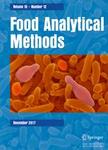版权所有:内蒙古大学图书馆 技术提供:维普资讯• 智图
内蒙古自治区呼和浩特市赛罕区大学西街235号 邮编: 010021

作者机构:Harran Univ Fac Engn Dept Food Engn Sanliurfa Turkiye Harran Univ Fac Sci & Letters Dept Chem Sanliurfa Turkiye
出 版 物:《FOOD ANALYTICAL METHODS》 (Food Anal. Methods.)
年 卷 期:2025年第18卷第5期
页 面:776-797页
核心收录:
学科分类:0832[工学-食品科学与工程(可授工学、农学学位)] 08[工学]
基 金:TEYDEP 1512 project of The Scientific and Technological Research Council of Turkey (TUBITAK) Scientific Research Projects Unit (HUBAK) of Harran University
主 题:Olive leaf extract Optimization modeling Microwave-assisted extraction PCA Antioxidant activity Total phenolic and flavonoid
摘 要:The bioactive properties of olive leaf extract (OLE) were investigated using various extraction methods, including microwave-assisted extraction (MAE), conventional extraction (CE), and maceration (Mc). Response surface methodology (RSM) was applied to analyze and optimize extraction parameters, such as microwave power and extraction time to maximize yield, total phenolic content (TPC), total flavonoid content (TFC), and antioxidant activity (measured by DPPH, ABTS(+), and CUPRAC assays). Half maximal inhibitory concentration (IC50) values for DPPH/ABTS(+) ranged from 8.57 to 14.80 mg/L, with the highest antioxidant activity observed in Mc. TPC and TFC values ranged from 85.21 to 169.20 mg GAE/g dry-weight and 1.49 to 111.98 mg Qrc/g dry-weight, respectively, with MAE yielding the highest polyphenol content. LC-MS/MS analysis identified eight major components in OLE, primarily oleuropein (12.99, 11.66, and 10.65 mg/ml) and quercetin (857, 231, and 1368 mg/L), with concentrations varying according to the extraction methods for MAE, CE, and Mc, respectively. The optimized conditions for CE (t = 30 min) and MAE (t = 30 min/350 W) were determined with desirabilities of 91.1% and 82.2%, respectively. Overall, extraction method, time, and MAE power significantly influenced response variables (P 0.05). MAE power (Watt) was identified as a more significant parameter than time. PCA analysis indicated that Mc was the most effective extraction method, while MAE at 250W showed the least efficiency, especially as higher power and longer durations negatively impacted bioactive metabolites. Notably, the RSM-optimized MAE parameters closely aligned with Mc in the PCA, suggesting mutual validation between these approaches in extracting bioactive components.